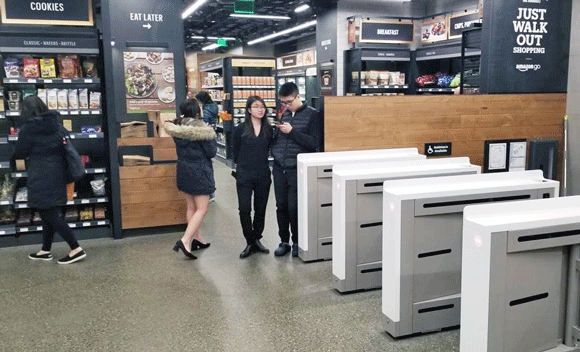Center director Jeff Cole reports back from his visit to Amazon’s sharpest-edge new cashier-less market and digs into the implications.
______________________________
By Jeffrey Cole
For the past few years, I have been briefing retailers, journalists, government officials, and just about anyone who listen about the Amazon Go Market. Even though when I started talking about Go it was still at least two years away, it was clear that it would be a game changer on many different levels.
 First, it will change the retail experience and our relationship to the stores where we shop. Second, it will greatly accelerate our desire to shop on our terms. Third, it will have a devastating impact on retail jobs (not just limited to markets). And, lastly, once we get used to it (very quickly), the Amazon Go market model is unstoppable. It will unalterably transform retail shopping.
First, it will change the retail experience and our relationship to the stores where we shop. Second, it will greatly accelerate our desire to shop on our terms. Third, it will have a devastating impact on retail jobs (not just limited to markets). And, lastly, once we get used to it (very quickly), the Amazon Go market model is unstoppable. It will unalterably transform retail shopping.
After talking for two years, last week during a trip to the Amazon mother ship in Seattle, I got my first opportunity to shop at an Amazon Go Market. It is everything Amazon promised and more. Traditional retail stores and the jobs associated with them are now under direct threat.
Amazon’s strategy to becoming one of the most successful companies on Planet Earth has been to remove any friction in the shopping experience. Along the way, its founder and CEO, Jeff Bezos, has become the richest man in the world.
In its early days, Amazon pioneered the one-click shopping button. Our address and credit information was built in so that one click was all that was needed to send a purchase on its way. Then Amazon developed its Dash buttons, each one for a different product, with pictures on the 50 cent-sized button with a sticky back. One push of the button (connected through wi-fi) also sent a product on the way. Amazon’s Alexa further simplified the buying process so that all that was needed was to say “Alexa, buy Tide Detergent.”
The Amazon Go market is the next step in the evolution of simplified, frictionless shopping.
The first Go Market opened in downtown Seattle near the Amazon headquarters. While it is only 1,800 square feet, the Go concept works equally well for a massive supermarket or warehouse store as well as a convenience store.
The concept for the store is remarkably simple and elegant. You download an Amazon Go app that produces a QR code on your phone and verifies that you are a Prime member. To get into the store, you scan the code that opens a turnstile.
Once inside, you take an item off the shelf, put it in your pocket or purse and walk out. Everyone looks like a shoplifter (and at first you feel like a shoplifter looking over your shoulder), but no one can steal. Shortly after leaving the store, a receipt is emailed to you. The staff in the store said it takes five minutes for the receipt to be sent; I found it was less than a minute.
Picking up a product means you bought it. Putting it back returns it. It is an ingenious system full of cameras in the ceiling and other highly developed technologies.
When you enter the store, you see a big sign that reads:
NO LINES, NO CHECKOUT
(No, Seriously!)
JUST WALK OUT SHOPPING
In the Go Market is a small alcohol section. A live human being patrols that section — not even allowing you to browse without verifying your age. In a traditional market, teens can walk past beer and wine, but have to show ID at the checkout to get it out of the store. Since in the Go Market you can (legally) slide it in your backpack, they have to know you are of age before you can touch it.
Once you get to know the layout of the store, if you need a product urgently or its an emergency, you can have someone park in front, you can run in, grab it (you know where it is), and leave — all within 30 seconds.
While there is always an adoption curve to new technology, I cannot see any customers, even the most technology-phobic, saying of the Go Store, “hey, I don’t like this. I would rather stand in line.” That is why it is unstoppable and will spread quickly.
_________________________________________________________________________________________________
The Amazon Go market model it will change the retail experience and our relationship to the stores where we shop. Second, it will greatly accelerate our desire to shop on our terms. Third, it will have a devastating impact on retail jobs (not just limited to markets). And, lastly, once we get used to it (very quickly), the Amazon Go market model is unstoppable. It will unalterably transform retail shopping.
_________________________________________________________________________________________________
Amazon says they will open 500 of the Go Markets. Undoubtedly, they will test it at their new retail laboratory, Whole Foods. Far more powerful may be the opportunity to license the Go Technology to retail stores around the world. No matter what course Amazon takes, it will profoundly affect retail.
I had some questions that Amazon was not yet ready (the Go Market is still an experiment) to answer. Does it ever make mistakes? I entered the market with a friend who is not a Prime member. What if he picks something up and walks out. What if I hand my purchase to him? What about children with their parents. These are all questions I would like to pursue.
The impact on retail jobs will be devastating. In previous columns I have outlined how driverless cars means that all driving jobs are on a path to oblivion. The Go Market means the same thing for most retail jobs. Even stocking the shelves may eventually (or soon) be done by robots.
We can keep checkers employed in markets and other stores by declaring that we are willing to pay higher prices at traditional stores and live with waiting in line. People in communities talk about how important it is to keep the local merchants in business and, yet, whenever a Walmart or Costco comes to town, people cannot resist the wider range and lower prices. There is no doubt the same will happen with the Go Market.
Amazon brought the Go Market to fruition exactly as they said they would. It is another innovation on their path to hassle-free and fun shopping. The Go Market compellingly makes the case that the innovations that are simplest to learn and use are the ones that change the world.
____________

Jeffrey Cole is the founder and director of The Center for the Digital Future at USC Annenberg.
See all columns from the Center.
April 11, 2018

